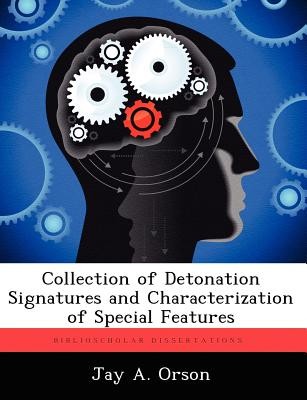
- We will send in 10–14 business days.
- Author: Jay A Orson
- Publisher: BiblioScholar
- ISBN-10: 1249584728
- ISBN-13: 9781249584728
- Format: 18.9 x 24.6 x 0.7 cm, softcover
- Language: English
- SAVE -10% with code: EXTRA
Collection of Detonation Signatures and Characterization of Special Features (e-book) (used book) | bookbook.eu
Reviews
Description
The remote observations of the temporal and spectral characteristics of the infrared (IR) emissions from exploding ordnance have been correlated with explosion conditions. A Bomem MR- 154 Fourier Transform Interferometer with two detectors, InSb and HgCdTe, and a 75 mrad telescope was used to record spectra in the 1.3 - 20 um range. Data was collected at spectral resolutions of 16 cm-1 and 4 cm-1 and temporal resolutions of 0.045 s and 0.123 s respectively. Two field tests were conducted: (1) a set of dynamic drop explosions and (2) a series of static detonations. In most events, the temporal profile for certain bands indicate a rapid, intense signature, followed by a secondary maximum and a long-term decay of up to several seconds. A second class of temporal profiles were characterized by an event initiation, followed by an increase in apparent radiance to one maximum, followed by a long-term decay. Sensor fusion between the FTIR instrument and four 200 Hz InSb radiometers is quite promising. The FTIR temporal profiles, calibrated for absolute radiance, compare within 8% in three independent bands and within 30 /0 in the fourth band. The degree of temporal overlap as a function of frequency for a pair of detonation events, provides a direct indication of the ability to discriminate between explosion conditions. Overlap analysis provides quantification of the repeatability of an explosive condition, and the discrimination between look angle and explosive type. Additional preliminary analysis mechanistically describes all events as decaying gray bodies.
EXTRA 10 % discount with code: EXTRA
The promotion ends in 18d.14:25:04
The discount code is valid when purchasing from 10 €. Discounts do not stack.
- Author: Jay A Orson
- Publisher: BiblioScholar
- ISBN-10: 1249584728
- ISBN-13: 9781249584728
- Format: 18.9 x 24.6 x 0.7 cm, softcover
- Language: English English
The remote observations of the temporal and spectral characteristics of the infrared (IR) emissions from exploding ordnance have been correlated with explosion conditions. A Bomem MR- 154 Fourier Transform Interferometer with two detectors, InSb and HgCdTe, and a 75 mrad telescope was used to record spectra in the 1.3 - 20 um range. Data was collected at spectral resolutions of 16 cm-1 and 4 cm-1 and temporal resolutions of 0.045 s and 0.123 s respectively. Two field tests were conducted: (1) a set of dynamic drop explosions and (2) a series of static detonations. In most events, the temporal profile for certain bands indicate a rapid, intense signature, followed by a secondary maximum and a long-term decay of up to several seconds. A second class of temporal profiles were characterized by an event initiation, followed by an increase in apparent radiance to one maximum, followed by a long-term decay. Sensor fusion between the FTIR instrument and four 200 Hz InSb radiometers is quite promising. The FTIR temporal profiles, calibrated for absolute radiance, compare within 8% in three independent bands and within 30 /0 in the fourth band. The degree of temporal overlap as a function of frequency for a pair of detonation events, provides a direct indication of the ability to discriminate between explosion conditions. Overlap analysis provides quantification of the repeatability of an explosive condition, and the discrimination between look angle and explosive type. Additional preliminary analysis mechanistically describes all events as decaying gray bodies.


Reviews